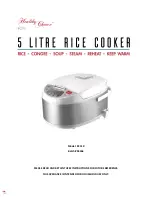
en
Environmental protection and saving energy
6
Damage
Cause
Measure
Blisters or fractures in
the glass
Knocks or falling cookware, cooking ac-
cessories or other hard or pointed objects.
When cooking, do not hit the glass or let ob-
jects fall onto the hob.
Scratches, discolour-
ation
Rough cookware bases or moving the cook-
ware on the hob.
Check the cookware. Lift the cookware when
moving it.
Scratches
Salt, sugar or sand.
Do not use the hob as a work surface or
storage space.
Damage to the appli-
ance
Cooking with frozen cookware.
Never use frozen cookware.
Damage to the cook-
ware or the appliance
Cooking without contents.
Never place or heat empty cookware on a
hot cooking zone.
Glass damage
Melted material on the hot cooking zone or
hot pot lid on the glass.
Do not place greaseproof paper or alu-
minium foil nor plastic containers or pot lids
on the hob.
Overheating
Hot cookware on the control panel or on the
frame.
Never place hot cookware on these areas.
2.3 Drawer area
Follow the corresponding instructions when using the
drawer.
ATTENTION!
Do not place hot objects in the plinth drawer. The plinth
drawer may be damaged.
▶
Do not place hot objects in the plinth drawer.
Do not place oven accessories that exceed the height
of the drawer into the plinth drawer. Otherwise, this
may damage the appliance.
▶
Do not place oven accessories that exceed the
height of the drawer into the plinth drawer.
3 Environmental protection and saving energy
3.1 Disposing of packaging
The packaging materials are environmentally compat-
ible and can be recycled.
▶
Sort the individual components by type and dispose
of them separately.
3.2 Saving energy
If you follow these instructions, your appliance will use
less power.
Only preheat the appliance if the recipe or the recom-
mended settings tell you to do so.
¡
Not preheating the appliance can reduce the en-
ergy used by up to 20%.
Use dark-coloured, black-coated or enamelled baking
tins.
¡
These types of baking tin absorb the heat particu-
larly well.
Open the appliance door as little as possible during
operation.
¡
This maintains the temperature in the cooking com-
partment and eliminates the need for the appliance
to reheat.
When baking multiple dishes, do so in succession or
in parallel.
¡
The cooking compartment is heated after baking
the first dish. This reduces the baking time for the
second cake.
If the cooking time is relatively long, you can switch
the appliance off 10 minutes before the cooking time
ends.
¡
There will be enough residual heat to finish cooking
the dish.
Remove any accessories that are not being used from
the cooking compartment.
¡
Accessories that are not being used do not need to
be heated.
Allow frozen food to defrost before cooking.
¡
This saves the energy that would otherwise be re-
quired to defrost it.
Note:
The appliance requires:
¡
A maximum of 1 W when the appliance is in opera-
tion with the display switched on
¡
A maximum of 0.5 W when the appliance is in oper-
ation with the display switched off
Saving energy
If you follow these instructions, your appliance will use
less power.
Select the cooking zone to match the size of your
pan. Centre the cookware on the hob.
Use cookware whose base diameter is the same dia-
meter as the hotplate.
Tip:
Cookware manufacturers often give the upper
diameter of the saucepan. It is often larger than the
base diameter.
¡
Unsuitable cookware or incompletely covered cook-
ing zones consume a lot of energy.







































